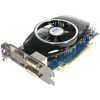- Qualcomm Launches Snapdragon 4 Gen 2 Mobile Platform
- AMD Launches Ryzen PRO 7000 Series Mobile & Desktop Platform
- Intel Launches Sleek Single-Slot Arc Pro A60 Workstation Graphics Card
- NVIDIA Announces Latest Ada Lovelace Additions: GeForce RTX 4060 Ti & RTX 4060
- Maxon Redshift With AMD Radeon GPU Rendering Support Now Available
Sapphire Radeon HD 5750

For a graphics card that retails for a suggested $130, the Radeon HD 5750 sure packs in a lot of features. In addition to its solid performance and superb power consumption, the card supports multiple monitor outputs, DirectX 11, Eyefinity and more. To top it all off, Sapphire includes a voucher for a free copy of Dirt 2 right in the box.
Page 5 – Crysis Warhead
Like Call of Duty, Crysis is another series that doesn’t need much of an introduction. Thanks to the fact that almost any comments section for a PC performance-related article asks, “Can it run Crysis?”, even those who don’t play computer games no doubt know what Crysis is. When Crytek first released Far Cry, it delivered an incredible game engine with huge capabilities, and Crysis simply took things to the next level.
Although the sequel, Warhead, has been available for just about a year, it still manages to push the highest-end systems to their breaking-point. It wasn’t until this past January that we finally found a graphics solution to handle the game at 2560×1600 at its Enthusiast level, but even that was without AA! Something tells me Crysis will be de facto for GPU benchmarking for the next while.
Manual Run-through: Whenever we have a new game in-hand for benchmarking, we make every attempt to explore each level of the game to find out which is the most brutal towards our hardware. Ironically, after spending hours exploring this game’s levels, we found the first level in the game, “Ambush”, to be the hardest on the GPU, so we stuck with it for our testing. Our run starts from the beginning of the level and stops shortly after we reach the first bridge.



Here’s where our results get to be a bit strange. Because Crysis usually tends to favor ATI cards just a wee bit, I expected to see the HD 5750 surpass the GTS 250 here. These results confused me so much, that I looked around the web, and sure enough, the HD 5750 beat out the GTS 250 in every set of results I found. I can’t explain the oddity here, but given that our 3DMark Vantage scores lined-up with what we expected to see, it’s hard to understand.
|
Graphics Card
|
Best Playable
|
Min FPS
|
Avg. FPS
|
|
NVIDIA GTX 295 1792MB (Reference)
|
2560×1600 – Gamer, 0xAA
|
19
|
40.381
|
|
ATI HD 5870 1GB (Reference)
|
2560×1600 – Gamer, 0xAA
|
20
|
32.955
|
|
ATI HD 5850 1GB (ASUS)
|
2560×1600 – Mainstream, 0xAA
|
28
|
52.105
|
|
NVIDIA GTX 285 1GB (EVGA)
|
2560×1600 – Mainstream, 0xAA
|
27
|
50.073
|
|
NVIDIA GTX 275 896MB (Reference)
|
2560×1600 – Mainstream, 0xAA
|
24
|
47.758
|
|
NVIDIA GTX 260 896MB (XFX)
|
2560×1600 – Mainstream, 0xAA
|
21
|
40.501
|
|
ATI HD 4890 1GB (Sapphire)
|
2560×1600 – Mainstream, 0xAA
|
19
|
39.096
|
|
ATI HD 4870 1GB (Reference)
|
2560×1600 – Mainstream, 0xAA
|
20
|
35.257
|
|
ATI HD 5770 1GB (Reference)
|
2560×1600 – Mainstream, 0xAA
|
20
|
35.256
|
|
NVIDIA GTX 250 1GB (EVGA)
|
2560×1600 – Mainstream, 0xAA
|
18
|
34.475
|
|
ATI HD 5750 1GB (Sapphire)
|
1920×1080 – Mainstream, 0xAA
|
21
|
47.545
|
If the HD 5750 lived up to my performance expectations, it would have been able to handle the game at 2560×1600 with no issue, but since it couldn’t, it fell behind the GTS 250 once again, and had to be pushed back to 1920×1080 with the Mainstream profile.
Support our efforts! With ad revenue at an all-time low for written websites, we're relying more than ever on reader support to help us continue putting so much effort into this type of content. You can support us by becoming a Patron, or by using our Amazon shopping affiliate links listed through our articles. Thanks for your support!






